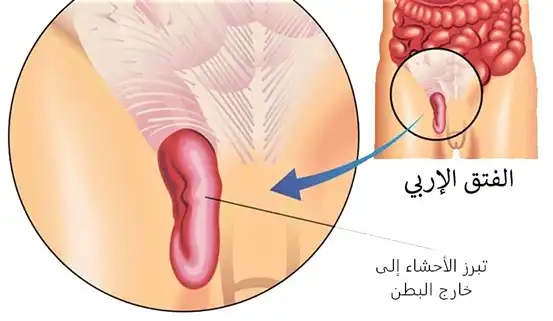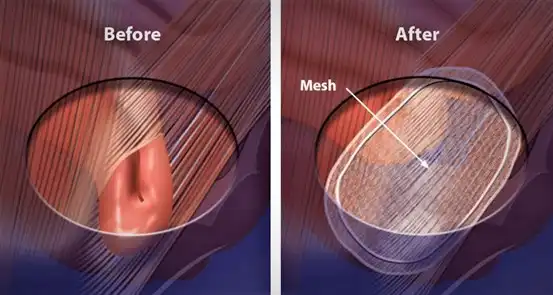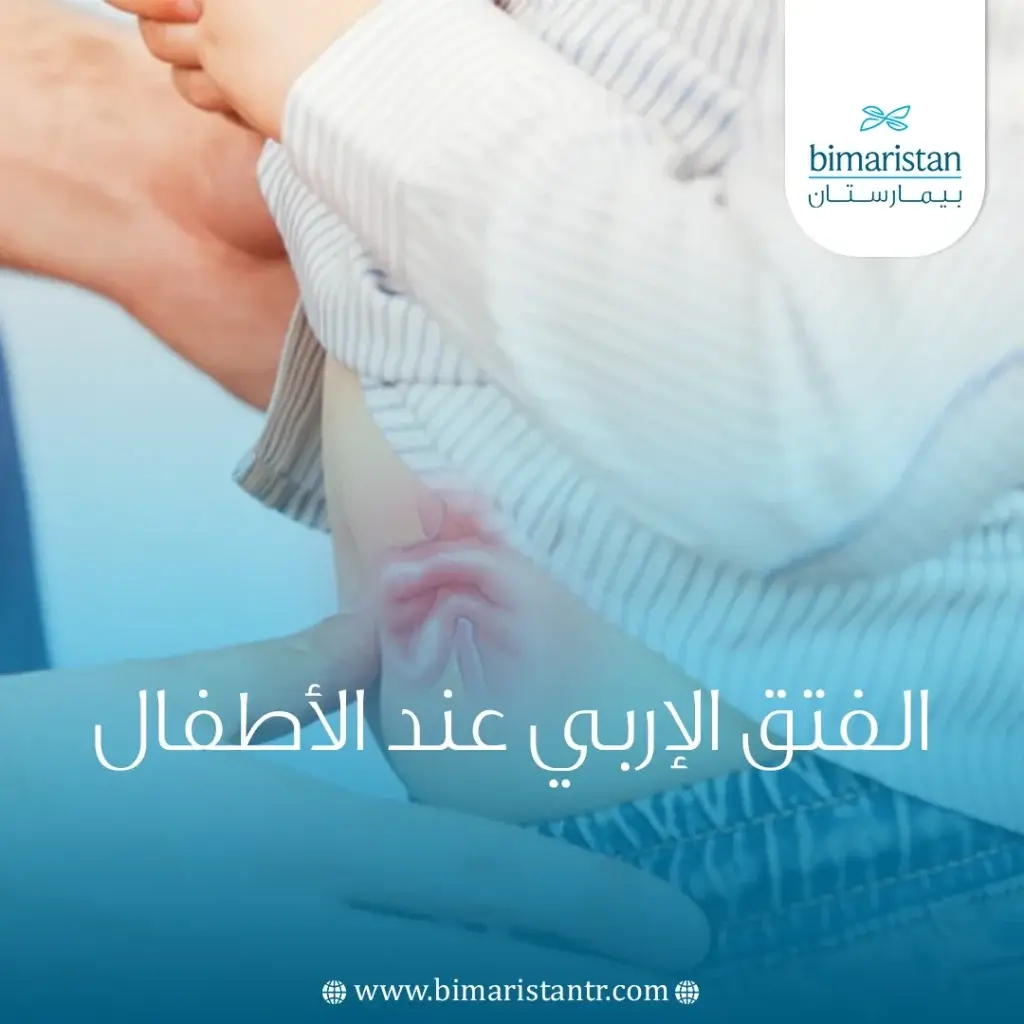يحدث الفتق الإربي inguinal hernia عندما تبرز الأنسجة الدهنية أو الأمعاء بسبب ضعف في جدار البطن ، يظهر الفتق الإربي على شكل انتفاخ في الناحية الإربية أسفل البطن. تعرف في هذه المقالة على اسباب الفتق الاربي وأشيع أنواعه ، الأعراض عند الأطفال والكبار والعلاج في تركيا.
الفتق هو حالة شائعة ينتفخ فيها جزء من العضو الداخلي أو الأنسجة الدهنية عبر العضلة بسبب ضعف فيها. يحدث الفتق الإربي عندما تنتفخ الأمعاء أو الدهون من البطن على شكل نتوء أو اندفاع عبر جدار البطن السفلي إلى المنطقة الأربية inguinal أو الفخذ.
ما هو اﻟﻔﺘﻖ الإربي ؟
الفتق هو حالة شائعة يخرج فيها جزء من عضو أو نسيج داخلي عبر العضلة بسبب ضعف فيها. يمكن أن يحدث الفتق حول زر البطن (السرة)، أو من خلال ندبة جراحية في الحجاب الحاجز أو في المنطقة الاربية inguinal (المنطقة الواقعة بين البطن والفخذ على جانبى الجسم).

ماهي أنواع الفتق الإربي؟
هناك نوعان من الفتق الأربي :
- الفتق الأربي غير المباشر: يحدث هذا النوع من لفتوق نتيجة عيب خلقي في عضلات (muscles ) جدار البطن .
- الفتق الإربي المباشر direct : والذي يحدث عند الذكور البالغين. غالبًا ما ينتج عن الضعف في عضلات جدار البطن الذي يتطور بمرور الوقت، أو نتيجة الإجهاد أورفع الأثقال.
يمكن أن يكون الفتق على أحد جانبي البطن أو كليهما. والفتق الأربي المباشر يعد الأكثر شيوعا لدى الكبار بسبب ضعف عضلات جدار البطن مع التقدم بالسن.
عادة لا يكون الفتق الإربي خطيرًا. ومع ذلك، يمكن أن يكون مؤلمًا، خاصة عند الرفع، أو الانحناء، أو الإجهاد ، أوالسعال.
من الذي يصاب بالفتق الأربي؟
يعد الرجال البالغين فوق سن 40 أكثر عرضة للإصابة بالفتق الأربي المباشر من الإناث. 25 ٪ من الرجال، وحوالي 2 ٪ فقط من النساء، سيصابون بفتق اربي في حياتهم.
يعد التاريخ العائلي للإصابة بالفتق الأربي والتدخين والرجال الذين خضعوا لجراحة سابقة في البطن عوامل خطورة للإصابة به.
ما هي أعراض الفتق الاربي؟
قد يكون الفتق الإربي غير مؤلم أو لا يسبب أي أعراض، خاصة عند ظهوره لأول مرة. تشمل اعراض الإصابة التي يمكن أن تتطور ما يلي:
- انتفاخ عند الفخذ، يبرز عند الوقوف و يختفي البروز عند الاستلقاء.
- ألم في الفخذ، خاصة عند الرفع أوالسعال أو ممارسة الرياضة.
- الشعور بضعف أو ثقل أو حرقان في الفخذ.
- بروز (كتلة) في الصفن عند الخصيتين .
كيف يتم تشخيص الفتق الإربي inguinal hernia ؟
إذا كنت تشك في إصابتك أنت أو طفلك بفتق اربي، فعليك طلب استشارة طبيب متخصص. إذا لم يعالج الفتاق، يمكن أن يُطور الفتق الإربي مضاعفات خطيرة.
قد يسأل مقدم الرعاية الصحية الخاص بك عن تاريخ العائلة، حيث يميل الفتق الاربى إلى الانتشار في العائلات. قد يقوم بعد ذلك بإجراء فحص بدني ليجس الفتق. قد يُطلب منك السعال أو الشد لمعرفة ما إذا كان الفتق قد خرج.
قد يُطلب إجراء تصوير بالأشعة السينية للبطن أو التصوير المقطعي المحوسب للتشخيص وتحديد ما إذا كان مختنقًا أو محبوساً.
هل تتطلب جميع أنواع الفتق الإربي جراحة؟
في بعض الأحيان، يمكن لمقدم الرعاية لصحية دفع أو “تقليل” الفتق الإربي الصغير مرة أخرى إلى البطن بتدليك لطيف و بسهولة. إذا لم ينجح ذلك، فقد تكون هناك حاجة لعملية جراحية.
لا يتحسن الفتق الإربي أو يختفي من تلقاء نفسه. إذا تم تشخيص إصابتك بفتق إربي، فمن المرجح أن يوصي طبيبك بإجراء عملية جراحية.
من النادر أن تحدث هذه المضاعفات ولكن يمكن أن يختنق الفتق أو ينحبس إذا تُرك بدون علاج.
- الفتق المحبوس: يحدث الحبس عندما يعلق جزء من الدهون أو الأمعاء من داخل البطن في الفخد أو الصفن ولا يمكن أن يعود إلى البطن.
- الفتق المختنق: يمكن أن يحدث الاختناق عندما لا يتم علاج الفتق المحبوس. يحدث قطع بتدفق الدم إلى الأمعاء، مما يؤدي إلى “خنق أو تموت” الأمعاء. هذه حالة خطيرة للغاية وإسعافية.
كيف يتم إصلاح الفتق الإربي؟
اصلاح الفتق الاربى inguinal hernia هو اجراء جراحي شائع. تسمى جراحه الفتق الإربي أيضًا برأب الفتق. هناك ثلاثة طرق لإصلاح الفتق الإربي:
- اصلاح الفتق بعمل جراحي مفتوح:اجراء جراحي يتطلب إحداث جرح في منطقة الفخذ. يعيد الجراح الأمعاء المنفتقة مرة أخرى إلى البطن ويقوي عضلات جدار البطن برقعة وغرز. تجرى تحت تأثير التخدير الموضعي ل منطقة البطن، أو التخدير العام .
- الإصلاح طفيف التوغل أو بالمنظار: اجراء جراحي أقل توغلًا يقوم فيه الجراح بعمل شقوق صغيرة نصف بوصة في أسفل منطقة البطن وإدخال منظار البطن (أنبوب رفيع مزود بكاميرا فيديو صغيرة). يتمكن الطبيب من القيام بهذا الإجراء الجراحى من خلال الشقوق الصغيرة.
- اصلاح الفتق بواسطة الروبوت: مثل الجراحه بواسطة المنظار، تستخدم الجراحه الروبوتية منظار البطن، ويتم إجراؤها بنفس الطريقة (شقوق صغيرة في جدار البطن ، وكاميرا صغيرة).
تختلف الجراحه الروبوتية عن الجراحه التنظيرية في أن الجراح يجلس في وحدة التحكم في غرفة العمليات، ويتعامل مع الأدوات الجراحية من وحدة التحكم. بينما يمكن استخدام الجراحه الروبوتية في بعض حالات الفتق الأصغر، أو المناطق الضعيفة، يمكن الآن استخدامها أيضًا لإعادة بناء جدار البطن.
الفتق الإربي عند الأطفال
تحتاج الفتوق إلى اصلاح جراحي عند الأطفال لمنع حدوث اختناق معوي أومضاعفات أخرى. تستغرق العملية حوالي ساعة وعادة ما تجرى في العيادة الخارجية (مما يعني أنه يمكن للمريض العودة إلى المنزل في نفس اليوم من الإجراء).
كيف يتم تحضير الطفل لعملية الفتق الاربي؟ ماهي خطوات الإجراء؟
يجب ألا يأكل طفلك لمدة 6 ساعات قبل العملية لتقليل مخاطر القيء واستنشاق السوائل تحت التخدير.
- تجرى العملية تحت التخدير العام. لن يشعر طفلك بألم أثناء العملية.
- إحداث شق صغير (من 2 إلى 3 سم) أسفل البطن بالقرب من الفخذ.
- تحديد “كيس” الفتق الذي يحتوي على جزء من الأمعاء الدقيقة.
- يدفع الجراح محتويات كيس الفتق (الأمعاء) إلى موضعها الصحيح خلف عضلات جدار البطن.
- إزالة كيس الفتق.
- تقوية عضلات جدار البطن بغرز لمنع أن يحدث فتق آخر.
- إذا كان عمر طفلك أقل من سنة واحدة، فإن احتمال أن يحدث فتق في الجانب الآخر من الفخذ مرتفع للغاية. لذلك يوصى بإصلاح كلا المنطقتين الأربية. إذا لم يكن هناك فتق حاليًا على الجانب الآخر من منطقة الفخذ، يجرى تقوية لعضلات الجدار بالغرز.

ماذا بعد جراحه الفتق الاربي؟
سيتمكن معظم الأطفال من العودة إلى المنزل بعد بضع ساعات من العملية. ومع ذلك، قد يحتاج الاطفال الخدج والأطفال حديثي الولادة المصابون بحالات طبية خاصة إلى قضاء ليلة واحدة في المستشفى للمراقبة.
يشعر طفلك بالتحسن في صباح اليوم التالي لعملية الفتق الأربي. بمجرد أن يصبح طفلك قادرًا، يمكنه استئناف عادات وأنشطة الأكل العادية.
يسمح للطفل بالاستحمام بعد يومين من العملية. ويجب الالتزام بالمضادات الحيوية الموصوفة من قبل الأطباء.
سيتم تحديد موعد للمتابعة بعد جراحه الفتق الأربي ب 7 إلى 10 أيام . سيقيم مقدم الرعاية لصحية الخاص بك الجرح والتئامه.
متى يجب أن اتصل بالطبيب بعد عملية الفتق الاربي؟
قد تلاحظ بعض التورم الطفيف حول الجرح أو في منطقة الصفن. هذا أمر طبيعي. ومع ذلك، اتصل بطبيبك بحال:
- عدم القدرة على التبول
- حمى
- انتفاخ شديد
- احمرار
- النزيف
- زيادة الألم
ما هي مخاطر عملية الفتق الإربي؟
تشمل مخاطر اصلاح الفتق الاربى inguinal hernia ما يلي:
- العدوى
- النزيف
- الألم الذي لا يمكن السيطرة عليه عن طريق الأدوية
المضاعفات طويلة الأمد نادرة، لكنها يمكن أن تشمل تلف الأعصاب أو نكس الفتق.
التعافي بعد جراحه الفتق الإربي
عادةً ما يتطلب التعافي من الجراحة المفتوحة عدة أسابيع لعلاج آلام ما بعد العملية. يُنصح أيضًا بعدم رفع أي شيء ثقيل أو ممارسة أنشطة عنيفة.
عادةً ما تستغرق الجراحه التنظيرية وقتًا أقصر للشفاء. ومع ذلك، قد لا يكون خيارًا للمرضى الذين يعانون من فتق كبير أو أولئك الذين خضعوا لجراحة سابقة في البطن.
يتعافى الرضع والأطفال أسرع من البالغين من عملية اصلاح الفتق الإربي.
كيف تتم الوقاية من نكس الفتق الإربي؟
بعد الجراحه، قد يُنصح بالحفاظ على وزن صحي وتجنب حمل الأشياء الثقيلة أو الإجهاد أثناء التبرز. يمكن أن تساعد هذه الخطوات في منع نكس الفتق الإربي.
يبقى مركز بيمارستان الطبي خيارك الأول للعلاج في تركيا.
نوجهك لأفضل و أشهر الاختصاصين الخبراء بكافة المجالات، نكسر حاجز اللغة أطباء متخصصين عرب سيساعدونك في التواصل مع طبيبك، نساعدك بحجز الموعد بأهم وأحدث المستشفيات الموجودة في تركيا ، نقدم خدماتنا لتأمين حجز فندقي لك و لمرافقينك إضافة للمواصلات للتنقل، نساعدك في تأمين تأشيرة السفر لك مجاناً.
نقدم خدماتنا على امتداد تركيا ، أفضل مكان بتقديم العلاج لك هو وجهتنا.
نرافقك خطوة بخطوة نحو الشفاء.
استشارات مجانية على مدار الساعة.
لا تتردد بالاتصال معنا، بيمارستان عائلتك في تركيا.

